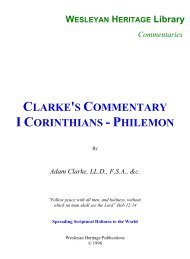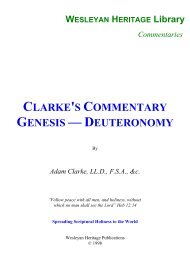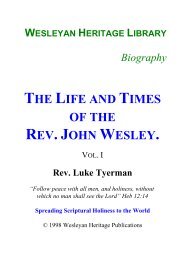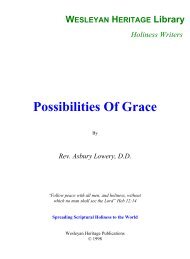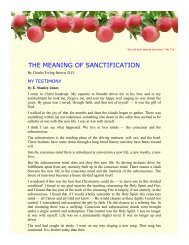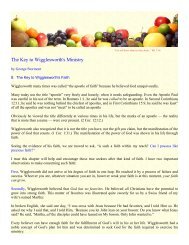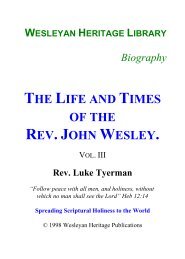W. B. Godbey - Enter His Rest
W. B. Godbey - Enter His Rest
W. B. Godbey - Enter His Rest
You also want an ePaper? Increase the reach of your titles
YUMPU automatically turns print PDFs into web optimized ePapers that Google loves.
NEW TESTAMENT TRANSLATION<br />
When the Commentaries began to circulate throughout the country, and the people reading them found the<br />
original Scriptures, which I always read and use in all my expositions, so much plainer and more easily<br />
understood than King James' translation, which not only contains two thousand errors in the New Testament<br />
alone, but, as it is nearly three hundred years old and the English language has undergone much change in that<br />
time, much of the phraseology has become antiquated, so that it no longer reveals the blessed truth so clearly<br />
and vividly to the mind of the student as does the verbiage now in current use.<br />
Therefore people began to plead with me to translate the New Testament out of the critical original into plain,<br />
current English. The reason why we have the two thousand errors in the English Version is because they had<br />
crept into the Greek during the long roll of the Dark Ages, which intervened between ancient and modern<br />
civilization, when barbarism actually captured the world, hovering over all nations like a nightmare. As the<br />
Roman Empire was the upholder of ancient civilization, When she fell under the invasion of the Goths, Huns,<br />
Vandals and Heruli, the barbaric ancestors of great Russia, after a three hundred years' war, in 476 A. D., ancient<br />
civilization passed away, followed by that dreary period of a thousand years, historically epitheted the “Dark<br />
Ages,” during which not one man in a thousand could read or write. Of course the perpetuation of the Bible by<br />
transcriptions would necessarily involve the introduction of much error, both by the omissions, as many<br />
beautiful passages rich in saving truth slipped through the fingers of the transcribers, and by the additions, as<br />
still more were added, first in the form of bracketed explanations, which eventually found their way into the<br />
body of the text, as transcribers overlooked or inadvertently neglected to perpetuate the parenthetical clauses.<br />
The predilection in favor of addition transcended the subtraction. Antecedently to the art of printing, A. D. 1551,<br />
the only possible chance to procure a Bible was to have it written off by hand, a work of immense labor and<br />
incalculable responsibility.<br />
During those fifteen centuries of course a vast amount of error incidentally found its way into the blessed<br />
Scripture. The printing of the Bible by Stephanus, in London, in 1551, was a sunburst on the English speaking<br />
world, as it forever did away with the necessity of transcribing, which was not only so immense a labor but was<br />
constantly fraught more or less with deterioration from the precious truth, thereby transmitted from age to age.<br />
One hundred and twenty-five years ago an institution denominated “Biblical Criticism” sprang up in<br />
Christendom, having for its object the recovery of the Scripture precisely as the Holy Ghost gave them, thus<br />
restoring to the Bible all of the lost passages as fast as they could find hem, and eliminating all of the<br />
interpolations which, along the rolling centuries, had found their way into the inspired volume. The result has<br />
been that a number of Greek Testaments have been printed, exhibiting the achievements of the critics, e. g.,<br />
Scholtz, Lachmann, Griesbach, Tischendorf, and Westcott and Horb [sic]. At present Westcott and Horb is the<br />
standard, as it is the youngest and consequently contains the benefit of all antecedent researches. It is, however,<br />
identical with Tischendorf, as they continued to publish his Testament after his death, giving their own names to<br />
it. Tischendorf's Testament, which I have used ever since it was published, has for its basis the Sinaitic<br />
manuscript, so called because Tischendorf discovered it in the convent of St. Catherine on Mt. Sinai, in 1859,<br />
the very year I graduated in college. Hearing the wonderful news of the greatest discovery of modern times, in<br />
the providence of God I procured from Germany a copy of the first book which was made from the parchment<br />
roll.<br />
This great scholar and critic, Tischendorf, spent his whole life in constant toil, for forty years in Palestine and all<br />
of the Bible lands hunting everything that would throw light on the living Word.<br />
Meanwhile noble and generous King William of Germany paid all of his expenses, a princely fortune, as he<br />
often had fifty to one hundred men laboring excavating the ruins of cities, that he might find everything that<br />
could possibly throw a ray of light on the vital fact of just what constitutes the inspired volume. Finally, while<br />
searching in that venerable monastery which was built in the second century to commemorate the giving of the<br />
law, he got his eye on an old parchment roll, externally indubitably demonstrative of its great antiquity, and the<br />
blessed Holy Spirit revealed to him that it was <strong>His</strong> Word. Then he at once proposed to the monks in charge of<br />
the monastery to buy it from them; soon, by his persistent effort, finding it necessary to tempt their cupidity with<br />
a really extravagant sum, as they are jealous of relics, and generally hold them with a tight grip which filthy



